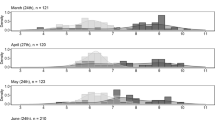Abstract
By removing males and controlling the rate of water flow past oviposition patches in an experimental area, we showed that female Calopteryx splendens xanthostoma preferred to oviposit in fast flowing water rather than slow flowing water. A series of manipulations revealed the fitness benefits to females for this preference: eggs placed in fast-flowing water developed significantly faster and showed significantly lower mortality than eggs placed in slow-flowing water. A major factor determining this difference was the deposition and growth of encrusting algae which prevented the successful hatching of eggs in slow-flowing water.
Similar content being viewed by others
References
Aarvidsson BL, Neergard R (1991) Mate choice in the willow warbler - a field experiment. Behav Ecol Sociobiol 29:225–229.
Alatalo RV, Lundberg A, Glynn C (1986) Female pied flycatchers choose territory quality and not male characteristics. Nature 323:152–153.
Alatalo RV, Glynn C, Lundberg A (1990) Singing rate and female attraction in the pied flycatcher: an experiment. Anim Behav 39:601–603.
Fincke OM (1986) Underwater oviposition in a damselfly (Odonata: Coenagrionidae) favors male vigilance, and multiple mating by females. Behav Ecol Sociobiol 18:405–412.
Fox HM, Wingfield CA, Simmonds BG (1937) The oxygen consumption of ephemerid nymphs from flowing and from still waters in relation to the concentration of oxygen in the water. J Exp Biol 14:306–320.
Gibbons DW, Pain D (1992) The influence of river flow-rate on the breeding behaviour of Calopteryx damselflies. J Anim Ecol 61:283–289.
Hasson O (1989) Amplifiers and the handicap principle in sexual selection: a different emphasis. Proc R Soc Lond B 235: 383–406.
Heymer A (1973) Beiträge zur Ethologie und Evolution der Calopterygidae. J Comp Ethol 1973 Supp II:4–94.
Leonard ML, Picman J (1988) Mate choice by marsh wren: the influence of male and territory quality. Anim Behav 36: 517–528.
Møller AP (1990) Male tail length and female mate choice in the monogamous swallow Hirundo rustica. Anim Behav 39: 458–465.
Moss R, Watson A, Parr R (1988) Mate choice by the hen red grouse Lagopus lagopus with an excess of cocks - role of territory size and food quality. Ibis 130:545–552.
Pajunen VI (1966) Aggressive behaviour and territoriality in a population of Calopteryx virgo L. (Odonata: Calopterygidae). Ann Zool Fenn 3:201–213.
Searcy WA (1979) Female choice of mates: a general model for birds and its application to red-winged blackbirds (Agelaius phoeniceus). Am Nat 114:77–100.
Siva-Jothy MT, Hooper RE (1995) The disposition and genetic diversity of stored sperm in females of the damselfly Calopteryx splendens xanthostoma (Charpentier). Proc R Soc Lond B 259:313–318.
Siva-Jothy MT, Tsubaki Y (1989) Variation in copulation duration in Mnais pruinosa pruinosa Selys (Odonata: Calopterygidae). 1. Alternative mate-securing tactics and sperm precedence. Behav Ecol Sociobiol 24:39–45.
Waage JK (1973) Reproductive behaviour and its relation to territoriality in Calopteryx maculata (Beauvois) (Odonata: Calopterygidae). Behaviour 47:240–256.
Waage JK (1979) Dual function of the damselfly penis: sperm removal and sperm transfer. Science 203:916–918.
Waage JK (1987) Choice and utilization of oviposition sites by female Calopteryx maculata (Odonata: Calopterygidae). Behav Ecol Sociobiol 20:439–446.
Yasukawa K (1981) Male quality and female choice of mate in the red-winged blackbird (Agelaius phoeniceus). Ecology 62:922–929.
Zahner R (1960) Über die Bindung der mitteleuropäischen Calopteryx Arten (Odonata, Zygoptera) an den Lebensraum des strömenden Wassers. 11. Der Anteil der Imagines an der Biotopbindung. Int Rev Hydrobiol Hydrogr 45:101–123.
Author information
Authors and Affiliations
Additional information
Communicated by R. Montgomerie
Rights and permissions
About this article
Cite this article
Siva-Jothy, M.T., Gibbons, D.W. & Pain, D. Female oviposition-site preference and egg hatching success in the damselfly Calopteryx splendens xanthostoma . Behav Ecol Sociobiol 37, 39–44 (1995). https://doi.org/10.1007/BF00173897
Received:
Accepted:
Issue Date:
DOI: https://doi.org/10.1007/BF00173897




